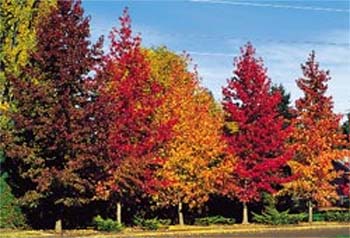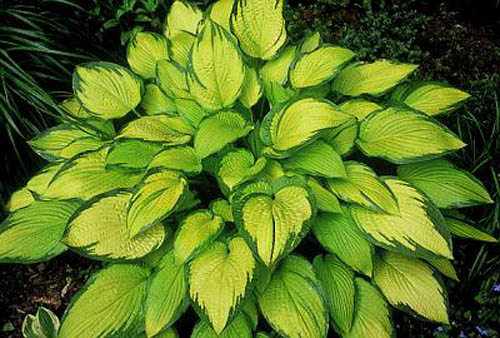We chose our family homesite because of it’s outstanding woodland setting. A meandering creek, majestic oaks and stately sycamores surrounding the home were hard to beat. “Buy Me!”the towering American Elm in the front lawn cried out.
Unfortunately, all was not perfect, not a single conifer adorned the landscape. This was not only unusual, as evergreens have unlimited use in the home landscape, but intolerable. We immediately set out to correct the problem. Now all we had to do was decide on what evergreens to use. With hundreds of conifer species available this was not an easy decision. Should we start with small, intermediate, large, or some combinations of all?
Since the area was so big and open, we decided to start with large evergreens. the American Conifer Society, considers large conifers to be ones with over twelve inches of growth a year. This somewhat helped us narrow our selection. Since we were on a tight budget, we chose balled and burlaped trees from 36-48 inches tall.
We next decided to plant a mixture of conifers, blending various textures, shapes and color. We also selected evergreens which were low maintenance and rapid growing. Priority was given to evergreens offering shelter for birds and wildlife.
While conifers also work well as hedges, screens, and windbreak plants, this was not a factor in our selection as we were looking for a more natural look. We also wanted plantings to quickly blend in with the existing trees and shrubs. To be honest we choose to ignore or at least push the limits, on some of the cultural requirements. Visual effects won out over soil conditions and sunlight requirements.
Fifteen years later, we can finally say that we made the right choices. We now have a very balanced landscape, one with four season appeal. This is not to say we are not making changes or additions, after all, this is what gardening is all about.
Here are the evergreens we choose and recommend for the home landscaper looking to add immediate impact to their gardens:
- Abies concolor ‘Concolor’
- – The Rocky Mountain White Fir needles are longer than most fir trees, averaging 2-3 inches in length and are quite soft while retaining a reasonable amount of stiffness. The broken needles and tree have a distinctive fragrance that is most frequently described as a mix of evergreen and citrus scents.
- Abies fraseri ‘Fraser Fir’
- – The species is sometimes called Southern balsam or Southern balsam fir. Locally Fraser fir is known as “She balsam” because of the resin filled blisters on the tree’s trunk. Red spruce, often associated with Fraser fir, is called “He balsam” and lacks the distinctive blisters. Fraser fir is a uniformly pyramid-shaped tree.
- Picea abies ‘Acrocona’
- – Norway Spruce is a large conifer that is well adapted to much of the upper midwest. It is faster growing than many of the other spruces. It has a pyramidal form, developing long, pendulous branchlets with age. On older specimens, the lateral branches arise horizontally from the trunk, droop slightly and then have a slight upward curve near the tips.
- Pinus strobus ‘Eastern White Pine’
- – Eastern White Pine is an excellent ornamental conifer and is also an important timber species. When well established, it has a rapid growth rate when young, with long distances between the lateral branches. Its form is somewhat pyramidal when young and becomes broad with age.
- Pseudotsuga menziesii ‘Douglas Fir’
- – Douglas fir is a large conifer that makes an excellent landscape plant for accent and grouping. It has a dense pyramidal form. Needles are 1-1 1/2 inches long and range in color from dark green to blue-green. Cones are readily distinguished from spruce and true firs by the papery bracts extending beyond the tips of the scales.
- Tsuga canadensis ‘Eastern Hemlock or Canada Hemlock’
- – Eastern hemlock is a graceful pyramid shaped evergreen conifer. Young trees have a slender pointed top shoot that droops and waves in the breeze. Older trees have an irregular rounded crown. The bark is cinnamon-brown with deep ridges.
Other trees which we added later and we also recommend are:
- Picea glauca ‘Conica’
- – White Spruce is a densely pyramidal evergreen conifer. The needles are dusty green to blue green in color. This spruce is quite adaptable to difficult conditions such as heat, cold and drought.
- Picea pungens ‘Thomsen’
- – Colorado Spruce is a stiffly pyramidal evergreen conifer. Horizontal branches reach to the ground, but form may become more open with age. Foliage occurs in a wide range of colors from green to silver-blue.
- Abies procera ‘Noble Fir’
- – Noble Fir is one of the largest true first of Northwest Pacific coast region. Dark gray brown and smooth, becoming brown to red brown, furrowed and broken into irregular scaly plates.
- Abies concolor ‘Lowiana’
- – The California White Fir is an attractive conifer and outstanding landscape plant. It has a formal pyramidal shape. Its silvery blue-green foliage makes it an ideal candidate for use as a specimen or accent plant in the landscape.
You can feel confident if you chose one or more of these evergreens they will do well in your garden. If we had to choose only one evergreen to use we would pick the Douglas Fir as it is so hardy and vigorous. Our second choice would be the Concolor Fir for it’s color and grace. Our sentimental favorite is Pinus flexilis ‘Vanerwolf’s Pyramid’, our Plant of the Month. An evergreen not listed above because it is not recommended for this area but someone forgot to tell it that. This tree has matured into a real eye catcher, we constantly get comments on it’s beauty.



